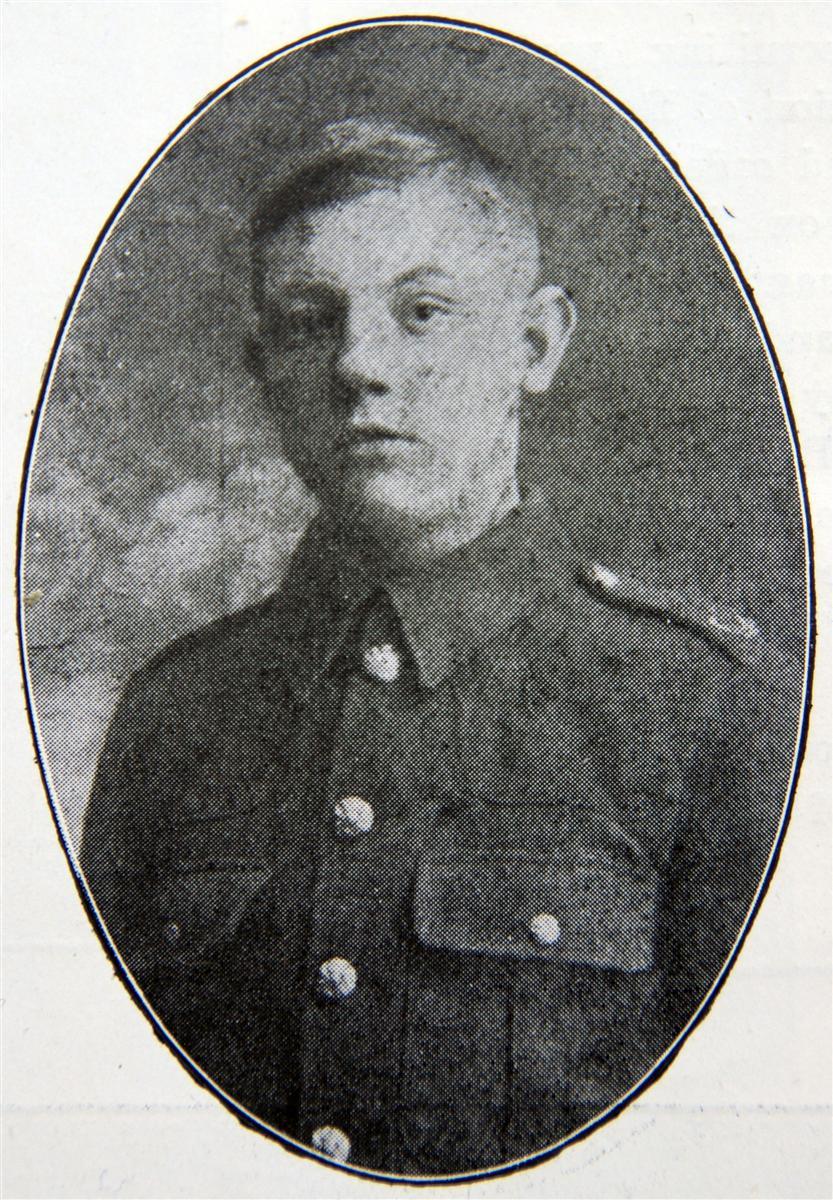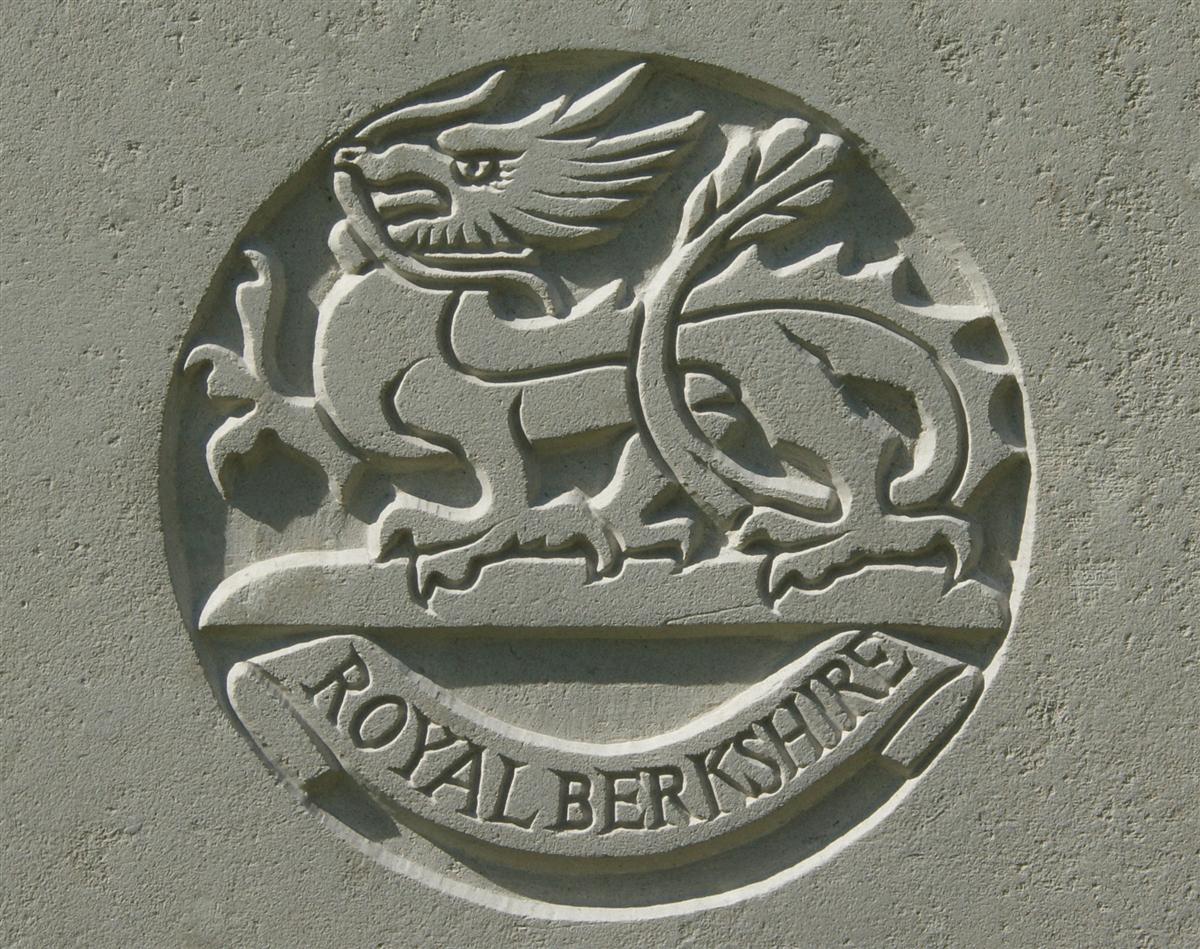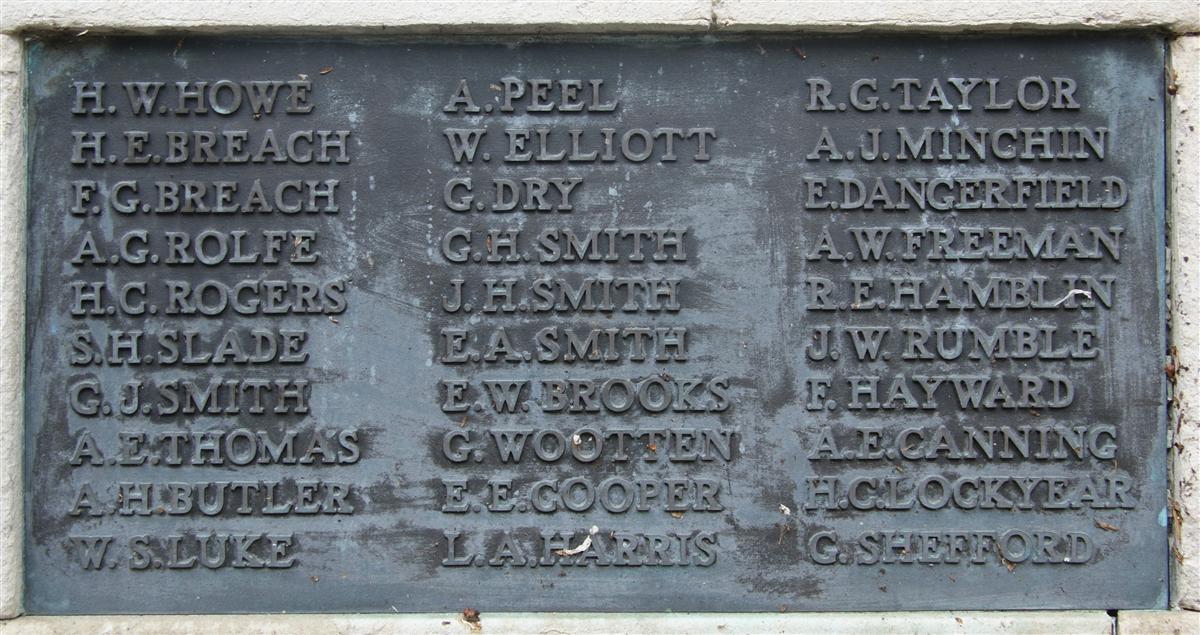George Herbert Smith
Private 9407 George Herbert Smith, 2nd Battalion Royal Berkshire Regiment

George Smith |
George was born in 1893, the fourth son and fifth child of George Smith and his wife Mary Ann. George senior was a blacksmith, born in Donnington, and did not travel far from his roots. His first children, Margaret Mary (1887) and Cecil Stuart (1888), were born in Bagnor, a short walk from the heart of Donnington village. The next three children, Isaac William (1891), James Henry (1892) and George Herbert (1893) arrived while the family was living in Speen; in truth Bagnor is a hamlet of Speen, and ‘Speen’ usually refers to the main village, Church Speen. One more child born in Shaw, Ernest Albert (1896) and finally, three more, Edith Annie (1899), Maude (1906) and Arthur (1909), in Newbury show the family’s moves over the years.
In Newbury they settled in Falcon Court, a small alley of three cottages that opened off Northcroft Lane, between the Temperance Hall and the former Child’s Almshouses. Their house, No 2, was a small four-roomed cottage that must have been very cramped if the whole family were there at once. However, the older children were flying the nest by the time their youngest siblings arrived. Isaac, the third child, opted for a job in khaki, signing up with the Royal Berkshire Regiment in January 1909 and served with the 2nd Battalion in India.
George followed Isaac’s example and signed up with the Royal Berks in late 1910 or early 1911. It is possible that he added a year to his age in order to sign up as an 18 year-old. The 1911 census finds him at Dover Castle serving with the 1st Battalion of the Royal Berks as a ‘19’ year-old. In 1912 A-Company was sent out to India to the 2nd Battalion allowing George to have a reunion with Isaac.
When war was declared in August 1914 the 2nd Battalion was recalled to England, leaving their Indian base at Jhansi on 14 September, travelling to Bombay with a few days in Deolali (source of the term ‘doolally’) for training and reorganisation. They sailed home via the Suez Canal and Gibraltar, landing in Liverpool on 23 October. Drafts of men from the 3rd Battalion brought them up to strength as they got to know their companions in the 25th Brigade, 8th Division which was assembling at Hursley Park outside Winchester. On 4 November the order came to march to Southampton for the crossing to France.

The regimental badge of the Berkshire Regiment, as used on CWGC headstones. |
Once in France the Battalion faced the rigours of trench warfare through a hard winter, so unlike the weather they had become accustomed to in India. In late November the Brigade war diary noted: “Sandbags were issued, two per man, to be worn, stuffed with straw, round men’s boots, to prevent frostbite.” A few days later there was another entry: “Men are suffering very much from their feet. The frost has gone and the weather is really mild, but, if anything, more men have been admitted to hospital than during the cold weather. It is understood that there are 800 men, from the Division, in hospital, from so called frost bite of the feet.”
The weather improved somewhat and the Allied High Command planned an offensive in the area of the German held village of Neuve Chappelle, which was launched on 10 March 1915. Initially the British and Indian troops involved had great success, capturing Neuve Chappelle as planned. However, determined German resistance and counter-attacks brought the advance to a standstill and the offensive was abandoned on 13 March. The 2nd Royal Berks were among the troops who captured Neuve Chapelle on 10 March, meeting relatively light opposition from German troops dazed by the effects of a British bombardment. On 11 May they were ordered to support another battalion against an anticipated German counter-attack, which did not materialise. The following day, 12 March, the 25th Brigade was ordered to attack across open ground. An artillery bombardment of the enemy positions starting at noon was largely ineffective and the Brigadier, fearing heavy losses from an enemy forewarned by the shelling, asked for permission to delay the attack until darkness. The response from Divisional HQ at 4pm was an order to attack at once.
The Brigadier’s foreboding was proved correct; brigade casualties that day were 24 officers and 549 men. Among these were 2 officers and 100 men from the 2nd Royal Berks – including George who was killed in action that day.
His death was reported in the local paper:
Newbury Weekly News, 22 April 1915 p8 – Local War Notes
Information has been received that Private George Herbert Smith, 2nd Royal Berks, was killed at the battle of Neuve Chappelle. He was the fourth son of Mrs G Smith of Falcon-court, Northbrook-street, Newbury. He had served five years in the Army, coming home from India with his regiment. There are two other brothers serving, one being wounded in the ankle at Ypres on November 25th.
George’s body lies in grave II.C.1 at Merville Communal Cemetery.
George came from a large family - the family's contribution to the war effort was marked in the local paper in 1917:
Newbury Weekly News, 8 November 1917 p8 – Local War Notes
The family record of Mr and Mrs G Smith of Falcon-court, is extremely creditable. They have had five sons serving in the Army, three of whom have paid the great sacrifice. Isaac William has served seven years, and has been twice wounded. George, who has been five years in the Army, was killed in the battle of Neuve Chapelle. James Henry was killed in action after having been in the army 10 months, as also Ernest Albert on October 13th, 1917, having served one year and nine months. Cecil Stuart is at present serving with the forces. Two daughters were employed on munition work, one having died, and the other being on the sick list.

George's name on Newbury War Memorial, above those of his brothers James and Albert. (middle) |
Locally George is remembered on Panel 10 of the Newbury Town War Memorial and both the parish memorial board and roll of honour in St Nicolas’ Church, Newbury. He was also remembered on a memorial board in Speenhamland School, now lost.
The same memorials also remember the names of his brothers, James Henry and Ernest Albert, who also lost their lives on the Western Front, as reported in the newspaper item above. Isaac survived the war but was wounded twice, the second occasion resulting in his discharge from the Army on 27 July 1916. Another brother, Cecil Stuart also donned the khaki uniform and survived; the sixth and final brother, Arthur, was too young to serve.
The sister reported in the paper as having died was probably the eldest, Margaret Mary; the death of a Margaret Smith was registered in Newbury in the April-June Quarter of 1917. The second sister employed on munition work was, Edith Annie; the third and final sister, Maude, was only eleven at the time.

Find a memorial :
| Died this day: | |
| 14 January 1902 | |
| A Bosley | |
| Newbury |

Like this site? Show your appreciation through a donation to a great charity.